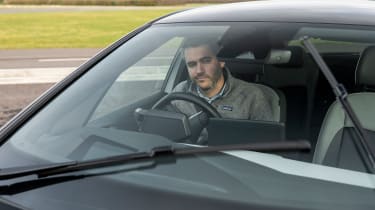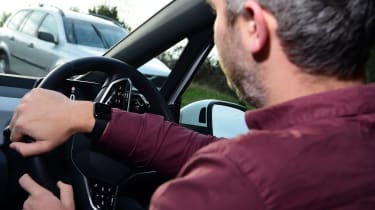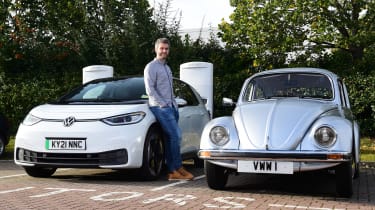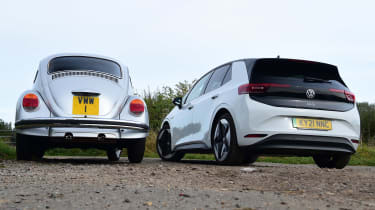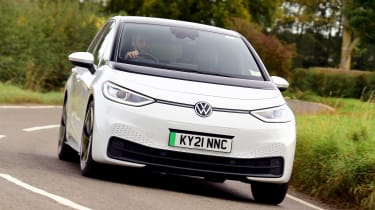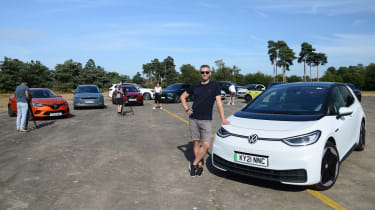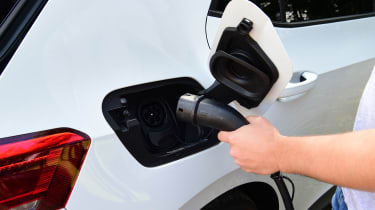Volkswagen ID.3 Pro S Tour: long-term test review
Final report: We find out about EV servicing before ID.3 leaves our fleet

Verdict
I’ll miss the ID.3. Its long range means it’s been really easy to live with, and as a car that just slipped in (and eventually out) of my life without drama, Volkswagen’s first dedicated EV has been brilliant.
- Mileage: 9,693
- Efficiency: 3.1miles/kWh
Anyone who owns a car will be familiar with the concept of servicing. Usually dependent on time or mileage, you book your car in with your local dealer and they give it a once over. All before relieving you of your hard-earned cash.
Some people set reminders, others wait for the letter to drop through the door or for the timely message to pop up on their car’s trip computer. For most owners, this is an annual occurrence, but for some electric car drivers it’s a different story.
Or at least that’s what I discovered recently when I went to book our ID.3 in for its first service at a Volkswagen dealer in West London. I was conscious the electric hatchback was approaching a year old without visiting a service department.
But on closer inspection (sorry, pun intended) it turns out that Volkswagen’s electric vehicles don’t require a check-up at all in the first two years. For comparison, most of the brand’s petrol or diesel models need an oil service after just a year or 9,000 miles – whichever comes first.
Used - available now

2023 Audi
A3 Sportback
19,678 milesManualPetrol1.0L
Cash £17,324
2024 Audi
A3 Sportback
30,795 milesManualPetrol1.5L
Cash £19,750
2024 Audi
A3 Sportback
17,333 milesManualPetrol1.0L
Cash £18,811
2021 Mercedes
A-Class
41,806 milesAutomaticDiesel1.5L
Cash £16,051Volkswagen’s customer site says that because there’s no oil to change, this can “save you money”. And while it’s true that you will spend less on servicing during the first 24 months of ownership, the fact is that you’ll also get less in the way of maintenance. One service (at two years) for an ID.3 costs £338.10; you’ll spend £386.16 servicing a Golf 1.5 TSI, getting two check-ups in the same period.
But what does an electric car service consist of if there’s no oil to change? As with any car, it turns out, the technicians check your brakes, headlights and tyres. They will also inspect the vehicle’s charging cables, as well as the high-voltage battery.
I am thankful that I don’t have to spend the best part of a day trekking across town to drop my car off for it to be serviced. I’m much happier sitting at home with software improvements being transferred over-the-air. There have been several of these, all carried out overnight and free of charge.
Regardless, my time with the ID.3 has come to an end. There have been times when I’ve wished it were a little bigger, and others when the half-baked infotainment set-up left me wanting. Yet overall it’s been dependable, comfy and easy to live with. Yes, efficiency has dropped since I was first given the keys back in September last year. The warmer temperatures saw the VW good for 300 miles, but this fell as low as 220-240 miles during colder spells.
I mentioned this on Twitter recently, and a follower (thanks @MrSaffron!) replied, saying that below eight degrees Celsius, the 77kWh ID.3 requires more heating power than smaller-battery models. He suggested a software update might lower the trigger point for the heater; VW couldn’t confirm when this might be available on existing cars, but said newly built ID.3s already have this software – straight from the factory.
I digress. Over nearly 5,000 miles the ID.3 has proven almost completely reliable; a flat tyre and an error with the parking sensors – the latter fixed over the air, naturally – are the only issues I’ve experienced. And the first of those was my fault.
For me, going for the top-spec model was worth it, too. As well as that bigger battery and longer range, it genuinely has all the equipment I could’ve asked for, except maybe a panoramic glass roof.
Unfortunately, at the time of writing, VW had paused orders of our Tour Pro S model, due to high demand and the ongoing semiconductor shortage. As it stands, the maker is offering just one variant, the ID.3 Life Pro Performance, fitted with the smaller 58kWh battery.
However, with LED lights, wireless phone charging and sat-nav, even that car comes well equipped as standard, and it should be much cheaper to buy.
Volkswagen ID.3 Pro S Tour: third report
Our Volkswagen ID.3 benefits from some over-the-air updates
- Mileage: 7,590
- Efficiency: 3.2 miles/kWh
Connected cars are the future, apparently. Whether that’s our sat-nav warning us of congestion en route, or being able to keep tabs on things like EV charge status, having our pride and joy trade info with its manufacturer and other drivers will, we’re told, make our lives easier.
If I’m honest, I’d largely dismissed this technology as a bit of a gimmick. But my perspective changed recently. I’d spotted notifications popping up on my VW ID.3’s infotainment screen a few times, informing me that the car was ready for an over-the-air (OTA) update. All I had to do was accept the message and leave the vehicle parked up overnight. All being well, I’d wake up to a car that was that little bit better than the one I had been driving the day before.
Over the past few months I’ve installed updates to the ID.3’s user manual, as well as “functional enhancements” for the lights. In early December, however, I noticed a selection of warning lights had stacked up on the dashboard, alongside messages suggesting various safety systems – including the car’s automatic emergency braking (AEB) set-up – weren’t functioning as intended.
Ordinarily, I’d have called up Citygate Volkswagen in west London and booked my car in as soon as possible. Yet only 48 hours later, an update appeared on my car’s central screen. It said I couldn’t drive the car for the best part of three hours, but I needn’t visit the workshop and, better still, it wouldn’t cost a penny in diagnostics or repairs – not to mention time ferrying the car to and from the dealer. It’s worth noting that while these updates are currently free, VW has said that some will be chargeable in the future.
The next morning the messages had cleared and I could drive the ID.3 safe in the knowledge that my family was protected every time we set off. I’d rather the car didn’t malfunction in the first place, but I can’t argue with the convenience of these potentially life-saving updates.
If experiences like these are anything to go by, there will surely be a time in the not-too-distant future when a vehicle’s myriad sensors can safely sign off your hatchback’s annual maintenance checks without you having to leave the house.
The convenience doesn’t end there, either. I’m still enjoying the ID.3’s relatively long range, even if efficiency has taken a hit recently. I’m currently managing around 3.2 miles per kilowatt hour, down from 3.7mi/kWh in September. That new figure means a range of around 245-250 miles – well shy of the WLTP-rated 338-mile maximum, but more than enough for my average use.
The VW continues to be a really easy car to live with, though – quick, comfortable and simple to drive. The long kit list ticks every box you’d expect, but I do wish the big 77kWh battery was available in the less-expensive Life or Family trims.
Volkswagen ID.3 Pro S Tour: second report
The iconic VW People’s Car gets to meet its all-electric spiritual successor
- Mileage: 6,824
- Efficiency: 3.5 miles/kWh
Volkswagen translates from German to English as “People’s Car” – a concept dreamt up in Germany in the years before World War II. The idea was, in short, to manufacture a cheap, simple-to-produce runaround for the country’s then-new road network.
That car was the “Type 1”, latterly and more comonly known as the Beetle. It was designed and engineered under Ferdinand Porsche, and went on to sell more than 21 million units over the model’s 65-year uninterrupted production run – a figure that doesn’t include either of the two “New Beetles”, launched in 1997 and 2011.
Fast forward to 2021, and Volkswagen is hoping it can bring new meaning to the term “People’s Car” with the help of its ID. electric sub-brand. It already boasts two distinct models – the ID.3 and ID.4 – and there are many more variants on the way.
Volkswagen’s range of ID. cars has the potential to be even more significant than the Beetle was. They launch at a time when world leaders are putting ever-increasing emphasis on limiting climate change, with the British Government having already confirmed a ban on the sale of new petrol and diesel cars by the end of the decade.
So, having recently taken delivery of a top-spec ID.3, I thought it was appropriate to draw some parallels with the original People’s Car. Luckily, Volkswagen UK’s heritage fleet is home to an immaculate 1977 Beetle 1200L, so we paid it a visit.
The first thing you notice when you sit in the Beetle is the sense of space, a feeling that’s also apparent in the ID.3. True, the former does without any sort of crash protection – even the seatbelts fit loosely across your torso – but the positive trade-off is an airy cabin with room for four people.
The Beetle’s engine is mounted behind the back seats and powers the rear wheels, just like the electric motor does in the ID.3. And while the controls are much heavier in the classic car, both models offer that old-school feeling of being pushed through corners rather than being pulled.
But here endeth the similarities. In the days of power steering, punchy electric motors and regenerative brakes, the Beetle feels positively archaic. Every trip is a test; turning the car around for photographer Pete Gibson felt like a workout, while slowing for junctions or approaching traffic required a level of anticipation that simply isn’t necessary when driving the ID.3.
And then there’s the in-car tech. The Beetle doesn’t even have a radio, let alone a modern touchscreen with nav or wireless phone charging. There is a single central speedo behind the steering wheel, however; perhaps the ID.3’s simplified driver’s display is an unwitting nod to its classic forbear.
Ultimately, though, while pootling around in the Beetle was fun, I was glad to go home in the ID.3. As a self-confessed petrolhead, I’ll always crave the interaction of changing gear myself and hearing the revs crescendo, but as a car to drive day-in day-out, EV pips petrol every time.
In fact, the more time I spend in the ID.3, the more I’m taken by the VW’s impressive usability. As I mentioned previously, our car is the range-topping Pro S Tour, so it’s got the largest 77kWh battery and plenty of kit. Even as the nights draw in and the temperatures drop, I’m consistently getting more than 250 miles (down from around 280-290 miles in the summer) on a charge.
It’s quick, quiet and easy to drive, and on all but the worst road surfaces it’s comfortable too. The technology on board is extensive but well integrated, and doesn’t feel intimidating like it does in some of the VW’s rivals. Plus, with wireless Apple CarPlay, I can keep my phone in my pocket and still have access to all my media, calls and nav – either via Waze or Google Maps.
Probably my biggest frustration is the boot, and the complete lack of a front trunk – or “frunk” as it’s colloquially known in EV circles. At 385 litres, the boot capacity is five litres bigger than you’ll find in a petrol VW Golf, but that’s with the movable floor in its lowest position, which leaves you nowhere to store the charge cables.
Volkswagen ID.3 Pro S Tour: first report
The impressive Volkswagen ID.3 EV joins our fleet fresh from winning an award from our sister title
- Mileage: 5,369
- Efficiency: 3.7 miles/kWh
When we get thrown the keys to a new long-term test car, it’s customary to take a while to let things bed in. What you think after a day or two can change dramatically over the weeks or months that follow.
But my new Volkswagen ID.3 was afforded no such luxury. Less than a week after it arrived, it was thrust into action with a run to Suffolk, where it joined the annual Car of the Year line-up for Auto Express’s sister title Carbuyer.
Alongside sports cars and SUVs, the ID.3 was judged the Best Small Company Car, as it was in the Auto Express New Car Awards in July. And it’s easy to see why. The demise of diesel is well documented, with strong EV incentives meaning business users are flocking to battery-electric cars in their droves. Paying just one per cent Benefit-in-Kind (BiK) tax makes a model like the ID.3 – if it suits your motoring life – a no-brainer.
Quickly comparing my ID.3 – a top-spec Pro S Tour variant, with the big battery and loads of kit – alongside a similarly equipped Golf (1.5 eTSI R-Line 150 DSG), shows how much the average company car driver will benefit. A higher-rate tax payer could save over £3,000 per year in BiK alone – or more than £9,000 over the course of a typical lease.
The age-old argument about range anxiety is beginning to fall on deaf ears, too. With more and more models now capable of 300 miles on a charge (the ID.3 Tour will do 340 miles officially, or around 290-300 miles in real-world driving), I’ve found very little need to rely on the patchy public charging infrastructure.
I’ve driven a lot of ID.3 models since the car was launched, and have always been keen to run one on the Auto Express fleet. Due to the nature of my job and the fact that I don’t have a driveway at home where I can just plug the car in, it made sense to opt for the biggest battery, which for the time being means I was forced to choose the most expensive Tour specification.
I’d be lying to suggest this is the sweet spot in the range – that accolade goes to either the entry-level Life or well equipped Family variants – but it does come with a long list of standard kit. As well as that large battery and plenty of range, Tour models get 19-inch alloy wheels, two-zone climate control, a head-up display, and keyless entry.
My car also has a few options, including 20-inch wheels and a heat pump. We hope the latter will help preserve that long range through the colder months to come.
Frustratingly, however, Tour models lose the rear bench in favour of two separate seats in the back; Volkswagen tells us a five-seat layout is due later this year. Boot space is on par with that of a petrol Golf, but with the boot floor in its top position, I’m forced to remove one wheel from my daughter’s buggy in order to get it in.
However, all this pales into insignificance when you switch the thing on and take it for a drive. The ID.3 is over 500kg lighter than my previous fleet car, a Mercedes EQC, and its lower centre of gravity means it feels much more agile as a result. And while the VW’s 201bhp might not sound like that much, the power delivery is instant and grip is good. Refinement, on the whole, is fine too, although those big wheels do generate more road noise than I’d like at speed.
So far, then, I’ve been enjoying the ID.3’s engaging handling, efficient powertrain and long range, plus its spacious cabin and minimalist design. There’s a lot to assess in the coming months, but so far, I’m loving life with the UK’s Best Small Company Car. 7,590 miles
| Model: | Volkswagen ID.3 Pro S Tour |
| On fleet since: | September 2021 |
| Price new: | £38,815 |
| Batt/motor: | 77kWh/1x e-motor, 201bhp |
| CO2/tax: | 0g/km/£0 |
| Options: | Glacier White paint (£645), 20-inch Sanya alloy wheels (£595), energy-efficient heat pump (£1,000), carpet mats – front and rear (£110) |
| Insurance*: | Group: 30/Quote: £539 |
| Mileage/efficency: |
9,693 miles/3.1miles/kWh |
| Any problems? |
Flat tyre (£214.50), parking sensor fault (fixed free OTA) |
*Insurance quote from AA (0800 107 0680) for a 42-year-old in Banbury, Oxon, with three points.




